Comprehensive Analysis of Mint State vs. Proof Coins
Difference Between Mint State and Proof Coins: Insights from a Seasoned Numismatist In my over two decades chasing the gleam of precious metals and coins, one question that keeps popping up is the difference between Mint State and Proof coins....

Difference Between Mint State and Proof Coins: Insights from a Seasoned Numismatist
In my over two decades chasing the gleam of precious metals and coins, one question that keeps popping up is the difference between Mint State and Proof coins. As a collector and investor, I've built portfolios around both, and understanding their nuances has been key to spotting real value. Mint State coins—often referred to as "business strikes"—are the everyday workhorses of the mint, struck for circulation but pulled pristine, while Proof coins are the showpieces, crafted with extra care for collectors like us. In this refresh, I'll break it down with post-1986 modern examples, drawing from my hands-on experience to help you decide which fits your strategy.
Key Takeaways
-
Mint State (MS) coins, graded MS-60 to MS-70 on the Sheldon Scale, shine for their uncirculated condition and historical tie-ins, making them a staple in my long-term holds.
-
Proof (PR) coins, graded PR-60 to PR-70, steal the spotlight with their mirror-like finishes and collector flair—I've always kept a few for that visual wow factor.
-
While far more MS coins are minted than PRs, perfect MS-70s are often rarer due to the high-volume business-strike process versus the meticulous polishing of dies and multiple strikes in Proof production, which boosts quality control.
Introduction

Diving into the difference between Mint State and Proof coins feels like peeling back the layers of numismatics' soul. From my early days grading Morgans to stacking modern Eagles, I've seen how MS coins capture raw mint freshness, while Proofs deliver that polished perfection. Both can supercharge a collection or portfolio, but knowing their distinctions—production, appeal, and rarity—lets you invest smarter. Let's unpack it, focusing on post-1986 moderns like American Silver and Gold Eagles, where I've found the most accessible entry points.
Understanding Mint State and Proof Coin Grading

Grading has evolved since I started, but the basics hold: Both use the Sheldon Scale, with MS or PR prefixes from 60 (choice) to 70 (flawless under 5x magnification, per PCGS standards). The grading process involves a detailed evaluation of the coin's surface, strike, luster, and overall coin's condition. Professional coin grading services like PCGS and the Numismatic Guaranty Corporation (NGC) play a crucial role in certifying a coin's quality and assigning grades.
I’ve slabbed hundreds through professional coin grading services such as PCGS and NGC, and that encapsulated certainty? It’s a game-changer for resale confidence.
In my view, the real magic is in the strike: MS coins get one solid hit on standard dies for efficiency, while Proofs? They’re pampered—planchets polished, dies buffed to a mirror sheen, and struck up to six times for razor-sharp details. That’s why, even though mintages for MS business strikes can hit millions (like the 2024 American Silver Eagle’s 5+ million), perfect MS-70s are scarcer beasts. The volume cranks up variability—bag marks, strike inconsistencies, and surface preservation (the coin's surface is a key factor in determining the coin's quality and final grade)—while Proof’s lower runs (say, 500,000 for the 2024 Proof Silver Eagle) allow for tighter quality, yielding more PR-70s.
What Are Mint State Coins?
Mint State coins are my go-to for that untouched-from-the-mint vibe—uncirculated business strikes never meant for pocket change but hoarded pristine. A mint state coin is an uncirculated coin that retains its pristine appearance, though it may exhibit slight imperfections or minor imperfections such as small marks or toning. These uncirculated coins are valued for the coin's condition, which is crucial in grading and overall value. Graded MS-60 to MS-70, they’re all about luster and minimal flaws; an MS-70 is my white whale, no post-mint dings visible up close. In the highest grades, post production imperfections are absent, ensuring a flawless finish.
From experience, high points like Liberty’s cheek on a Silver Eagle tell the tale—soft strikes drop the grade fast. Mint marks (W for West Point, S for San Francisco) add flavor, boosting value on scarcer ones. They’re produced en masse for bullion demand, with large quantities being typical for Mint State coins, but in my stacks, the thrill is hunting those rare high graders.
Common Characteristics
-
Lustrous fields with potential minor contact marks from handling or tumbling.
-
Struck once or twice on unpolished planchets for speed.
-
Eye appeal hinges on strike quality and originality—no toning unless choice.
Examples of Popular Mint State Coins (Post-1986)
I’ve flipped plenty of these: A 2024 American Gold Eagle in MS-70 (1 oz) commands over $2,600 as of early October 2025, riding gold’s spot plus a premium for perfection. Or take the 2024 American Silver Eagle MS-70—around $40-$50, but key low-mintage variants like the Burnished edition push $100+. Coins with high grades, especially those from key dates with lower mintages, are particularly sought after by collectors and investors due to their rarity and potential for higher appreciation. Their populations? For the 2024 Silver Eagle, PCGS shows thousands in MS-70, but that’s still a fraction of total mintage, underscoring the rarity grind.
What Are Proof Coins?
Proof coins? They’re the art pieces in my display case—specially struck for collectors, not circulation. Using those gleaming dies and prepped planchets, they emerge with mirror fields and frosted devices, graded PR-60 to PR-70. Proof coins are renowned for their mirror-like surfaces and mirror-like fields, which highlight the intricate design details achieved through a specialized minting process. These coins are intended for collectors only, and the United States Mint has a long history of producing these special coins for numismatic purposes. I’ve cherished PR-70 Deep Cameo (DCAM) Proofs for their contrast pop; it’s like holding a mirror to history.
Not for pockets—these come boxed or cased, often with certificates. The multi-strike process etches details deeper, minimizing flaws and why PR-70s outnumber MS-70s in pops despite tiny mintages.
Key Characteristics
-
Mirror-like backgrounds with raised, frosty designs for drama.
-
Struck multiple times slowly, yielding superior relief.
-
Variants like DCAM (high contrast), CAM (medium), or standard—DCAMs are my favorites for auction sizzle.
Examples of Popular Proof Coins (Post-1986)
Spot on with moderns: The 2024 American Silver Eagle PR-70 DCAM fetches $150-$200 right now, with the W-mint Enhanced Proof version hitting $230-$455 for its privy mark flair. Then there’s the 2024 Proof Gold Buffalo PR-69 CAM—over $2,900, a beast for its .9999 purity and limited run. Many of these modern Proof coins have limited mintages, which adds to their exclusivity and can drive higher value among collectors. PCGS pops for the 2024 Proof Silver Eagle show robust PR-70 counts, thanks to that controlled crafting.
Key Differences Between Mint State & Proof Coins

I’ve boiled it down in this table from my notes, cross-checked against CoinWeek insights—MS for condition kings, PR for presentation pros.
|
Aspect |
Mint State (Business Strike) |
Proof (Collector Strike) |
|---|---|---|
|
Production |
High-volume, single strike on standard dies; produced as business strike coins for everyday use as circulating coins (regular coins or money) |
Low-volume, multiple strikes on polished dies/planchets; not intended for use as money |
|
Mintage |
Millions (e.g., 5M+ for 2024 ASE MS); common among circulating coins |
Hundreds of thousands (e.g., 500K for 2024 ASE PR) |
|
Finish |
Satiny luster, potential bag marks typical of regular coins |
Mirror fields, frosted devices, high contrast |
|
Grading Focus |
Luster (20%), strike (20%), surface (40%), eye appeal (20%) |
Similar, but emphasizes contrast and sharpness |
|
Rarity of -70 |
Rarer due to volume variability (fewer MS-70s) |
More common; process yields higher perfection rates |
|
Appeal |
Historical/circulation tie, bullion stability; reflects the journey of money through commerce |
Aesthetic exclusivity, collector premium |
|
Value Driver |
Condition rarity in high mintages |
Limited edition + visual strike |
Collectors often focus on collecting Mint State and Proof coins for their pristine condition and investment potential, rather than other coins that have been used in commerce. However, the grading skills developed on these coins can also be applied to other coins, including regular coins and circulating coins, broadening your collecting strategy.
Grading Mint State Coins
Grading MS coins is part detective work, part art—I’ve spent hours under loupes assessing surface preservation first (those telltale marks), then strike, luster, and that subjective eye appeal. The highest grade, MS-70, is considered a perfect coin, meaning it has no visible imperfections under magnification. The Morgan Silver Dollar was my training wheel; master its cheek and hairlines, and everything clicks. Pros like PCGS slab ‘em for authenticity, a must in my book to dodge fakes.
Investment Value: Which Is Better—Mint State or Proof Coins?

Both pack punch, but I’ve tailored my buys to goals. MS coins anchor my portfolio for steady growth—tied to metal spots and scarcity. High-grade MS-70s like the 2024 Gold Eagle have climbed 10-15% yearly in my holds, fueled by economic jitters.
Understanding market dynamics is crucial for collectors and investors alike, as it helps them make informed decisions about which coins to acquire for their portfolios.
Proofs? They’re my speculative sparks—exclusivity drives pops. A PR-70 DCAM 2024 Silver Eagle has doubled from issue price in under a year for me, per auction trends. MS offers broader liquidity; PRs, niche upside. Diversify, I say—I’ve balanced both for resilience.
Common Myths About Mint State and Proof Coins

Myths die hard, but data debunks 'em:
-
Myth 1: Proofs always outvalue MS coins. Nope—MS-70 2024 Gold Eagles eclipse most PRs in raw scarcity, per PCGS pops.
-
Myth 2: Proofs are just for hobbyists. Wrong; I've resold PR-70s at 50% premiums to investors chasing limited runs.
-
Myth 3: MS coins are "regular" if pretty. Hardly—they're uncirculated gems, worlds from circulated junk.
Education's your edge—I've learned the hard way.
How to Choose the Right Coins for Your Collection or Investment Portfolio
Start with intent: History buffs, grab MS-65+ 2024 Silver Eagles for that bullion backbone (~$50). Aesthetic chasers? PR-70 DCAM Proofs for the shine ($150+). Collect coins that align with your interests and investment goals to build a collection you’ll enjoy and value. Gauge demand via PCGS population reports and Heritage Auctions—low pops signal upside. Always source from trusted spots like Global Coin; their slabs are gold (literally).
Storage and Preservation
I've rued mishandled coins—store in cool, dry safes, glove up for touches, and use PCGS slabs or inert holders. Humidity's the enemy; my dehumidified vault keeps 'em pristine.
Recent Trends in the Market
As of October 2025, with gold hovering and silver sparking, modern MS and PR Eagles are hot. MS-70 pops lag PR-70s, per PCGS, driving premiums—2024 Silver Eagle MS-70s up 20% YTD, Proofs 15%. Collectors crave perfection; I've seen W-mint variants fly at shows.
Conclusion
The difference between Mint State and Proof coins? It's condition versus craftsmanship, volume versus finesse—both winners in my book. With MS-70s rarer despite the numbers and PRs offering that elite edge, blend 'em for a bulletproof stack. In this volatile world, they're more than metal; they're your hedge. Dive in confidently—head to Global Coin for those flawless moderns today. Your collection awaits.
Frequently Asked Questions
What's the main difference between Mint State and Proof coins?
MS coins are business strikes—uncirculated for circulation potential—while Proofs are collector specials with polished, multi-struck perfection. MS-70s rarer overall, despite higher mintages.
Are Proof coins always more valuable than Mint State?
Not at all—MS-70 2024 Gold Eagles top $2,600, outpacing many PRs, thanks to scarcity in high-volume strikes.
Why are MS-70 coins rarer than PR-70s for moderns?
Business strikes churn millions with less control, breeding flaws; Proofs' polished process and lower volumes yield more perfects.
Best modern examples for beginners?
Start with 2024 American Silver Eagle: MS-70 (~$50) for value, PR-70 DCAM (~$150) for appeal.
Where to buy authenticated MS and PR coins?
Global Coin—secure, slabbed, and expert-vetted. It's where I source my keepers.
Related Articles

History of US Mint: A Comprehensive Guide from Founding to Present Day
The United States Mint, often simply called the U.S. Mint, stands as a cornerstone of American e...
Discover More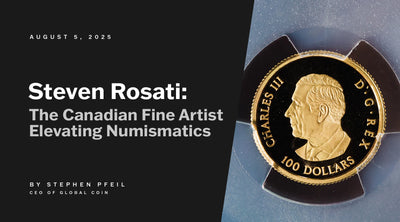
Steven Rosati: The Canadian Fine Artist Elevating Numismatics
As the founder of Global Coin and a numismatist with over 20 years of experience, I’ve handled co...
Discover More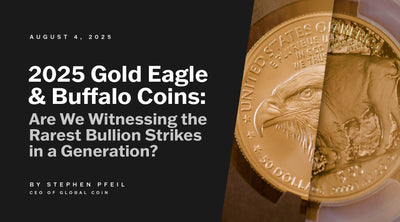
2025 Gold Eagle and Buffalo Coins: Are We Witnessing the Rarest Bullion Strikes in a Generation?
In a world where gold is more than just a commodity—where it’s a legacy asset, a hedge against ...
Discover More

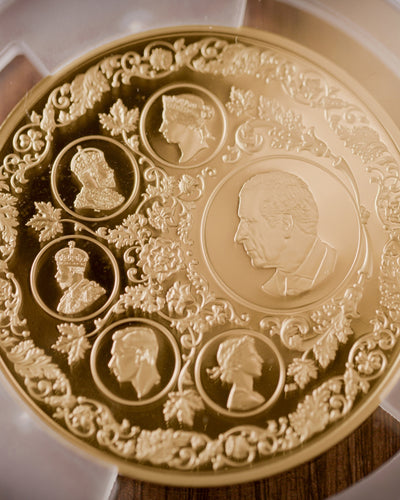
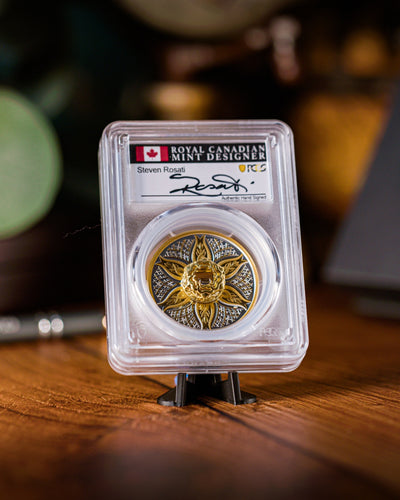
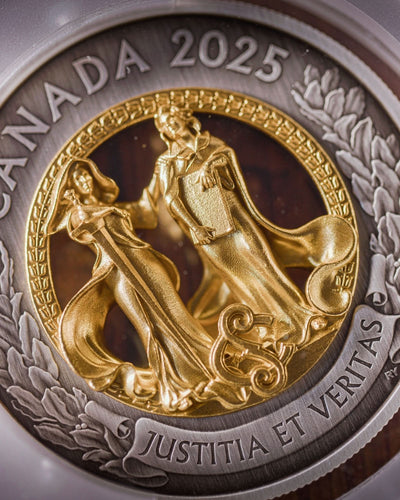
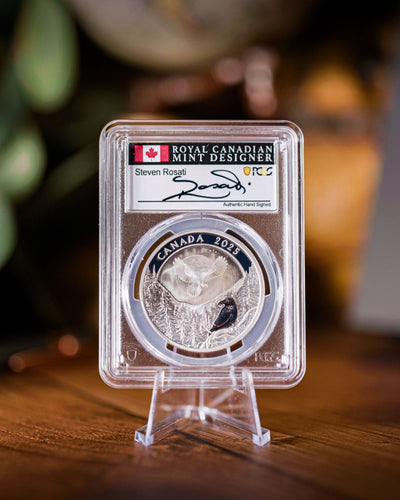
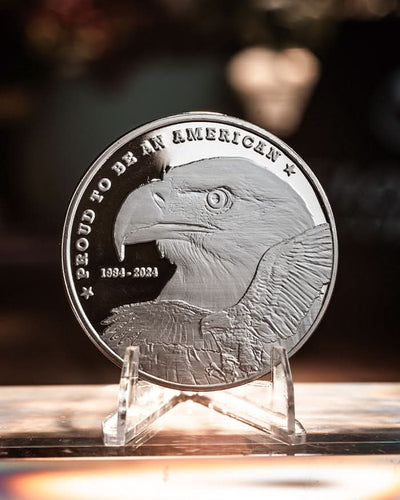
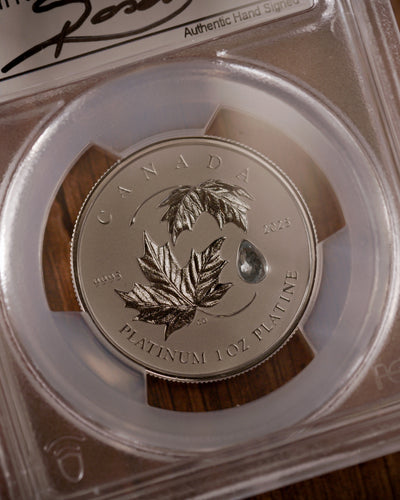

Leave a comment
This site is protected by hCaptcha and the hCaptcha Privacy Policy and Terms of Service apply.